| Listing 1 - 10 of 414 | << page >> |
Sort by
|
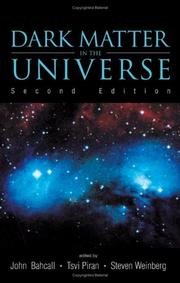
ISBN: 1281880701 9786611880705 9812567186 9789812567185 9812388400 9789812388407 9812388419 9789812388414 Year: 2004 Publisher: Singapore Hackensack, N.J. World Scientific
Abstract | Keywords | Export | Availability | Bookmark
 Loading...
Loading...Choose an application
- Reference Manager
- EndNote
- RefWorks (Direct export to RefWorks)
If standard gravitational theory is correct, then most of the matter in the universe is in an unidentified form which does not emit enough light to have been detected by current instrumentation. This book is the second edition of the lectures given at the 4th Jerusalem Winter School for Theoretical Physics, with new material added. The lectures are devoted to the ""missing matter"" problem in the universe, the search to understand dark matter. The goal of this volume is to make current research work on unseen matter accessible to students without prior experience in this area and to provide insights
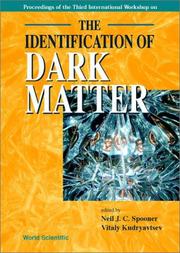
ISBN: 9812811362 9789812811363 9789810246020 9810246021 Year: 2001 Publisher: Singapore River Edge, N.J. World Scientific
Abstract | Keywords | Export | Availability | Bookmark
 Loading...
Loading...Choose an application
- Reference Manager
- EndNote
- RefWorks (Direct export to RefWorks)
The objective of the workshop series "The Identification of Dark Matter" is to assess critically the status of work attempting to identify what constitutes dark matter; in particular, to consider what techniques are currently being used, how successful they are, and what new techniques are likely to improve the prospects for identifying dark matter candidates in the future. This proceedings volume includes reviews on major particle astrophysics topics in the field of dark matter, as well as short contributed papers.
Book
ISBN: 1281897418 9786611897413 9812701842 9789812701848 9781281897411 6611897410 Year: 2005 Publisher: Singapore Hackensack, N.J. World Scientific
Abstract | Keywords | Export | Availability | Bookmark
 Loading...
Loading...Choose an application
- Reference Manager
- EndNote
- RefWorks (Direct export to RefWorks)
The prestigious Identification of Dark Matter workshop series was initiated to assess the status of work that attempts to identify the constitution of dark matter. In particular, it aims to review the success of current methods that are used in the search for dark matter, as well as the new techniques that are likely to improve prospects for detecting possible dark matter candidates in the future. In the 5th International Workshop, special emphasis was placed on the recent results obtained in experiments searching for baryonic and non-baryonic dark matter. This volume comprises the high-qualit
Book
ISBN: 1613246226 9781613246221 9781608764730 1608764737 Year: 2010 Publisher: New York Nova Science Publishers
Abstract | Keywords | Export | Availability | Bookmark
 Loading...
Loading...Choose an application
- Reference Manager
- EndNote
- RefWorks (Direct export to RefWorks)
Book
ISBN: 1281933848 9786611933845 9812791310 9789812791313 Year: 2003 Publisher: River Edge, NJ World Scientific
Abstract | Keywords | Export | Availability | Bookmark
 Loading...
Loading...Choose an application
- Reference Manager
- EndNote
- RefWorks (Direct export to RefWorks)
This book contains written versions of the presentations made at the 4th International Workshop on the Identification of Dark Matter (IDM 2002), held in York, UK, in September 2002. The objective of this workshop series is to assess the status of work attempting to identify what constitutes dark matter - in particular, to consider the techniques being used, how successful they are, and what new techniques are likely to improve prospects for identifying likely dark matter candidates in the future. At IDM 2002 special emphasis was placed on recent results obtained in searches for baryonic and no
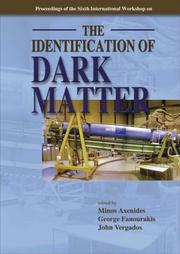
ISBN: 1281919098 9786611919092 9812770283 9789812708526 9812708529 9789812770288 9781281919090 6611919090 Year: 2007 Publisher: Singapore Hackensack, NJ World Scientific
Abstract | Keywords | Export | Availability | Bookmark
 Loading...
Loading...Choose an application
- Reference Manager
- EndNote
- RefWorks (Direct export to RefWorks)
This volume is the latest in a prominent biannual series of scientific meetings on the exciting research topics of dark matter and, more recently, of dark energy. It contains a state-of-the-art update on detection efforts by experimental groups around the world trying to pin down exotic new forms of matter under the names of axions, neutralinos, wimps, primordial black holes, q balls, sterile neutrinos, as well as a tantalizing new form of dark energy component called phantom energy and quintessence. The book is self-contained as it also includes general reviews on recent cosmological observat
Book
Year: 2022 Publisher: London, United Kingdom : IntechOpen,
Abstract | Keywords | Export | Availability | Bookmark
 Loading...
Loading...Choose an application
- Reference Manager
- EndNote
- RefWorks (Direct export to RefWorks)
This book presents several new, important explanations for dark matter, all dissimilar to the discredited subatomic particle-like but invisible matter. One chapter presents evidence that abundant cold hydrogen, baryonic matter, is the source of the missing gravity. Another chapter suggests that dark matter is better explained by stars in spiral galaxies that follow non-Keplerian orbits. A third chapter proposes that gravity attributed to dark matter is due to the sprinkling of black holes throughout galaxies, which is supported by LIGO/Virgo observations. Another chapter questions the assumptions of the Friedmann (FLRW) model, proposing a better method for handling astrophysical data. Additional chapters discuss cosmic ray propagation, axion decay, the cosmological scale factor, and the philosophical outlook of cosmologists when dealing with the questions of dark matter and dark energy.
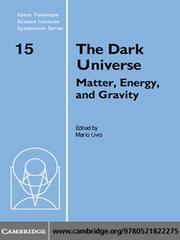
ISBN: 1107145880 1280750251 9786610750252 0511265522 0511266243 0511263996 0511313462 0511536291 051126450X 9780511266249 051126206X 9780511262067 9780511265525 9780521822275 0521822270 0521822270 9781107145887 9781280750250 6610750254 9780511263996 9780511313462 9780511536298 9780521134033 Year: 2003 Publisher: Cambridge, UK New York Cambridge University Press
Abstract | Keywords | Export | Availability | Bookmark
 Loading...
Loading...Choose an application
- Reference Manager
- EndNote
- RefWorks (Direct export to RefWorks)
This 2004 book reviews the findings on the composition of the universe, its dynamics, and the implications of both for the evolution of large-scale structure and for fundamental theories of the universe. With each chapter written by a leading expert in the field, topics include massive compact halo objects, the oldest white dwarfs, hot gas in clusters of galaxies, primordial nucleosynthesis, modified Newtonian dynamics, the cosmic mass density, the growth of large-scale structure, and a discussion of dark energy. This book is an invaluable resource for both professional astronomers and graduate students.
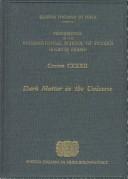
ISBN: 1614992177 9781614992172 9051992947 9789051992946 4274901289 9784274901287 Year: 1996 Publisher: Amsterdam Washington, DC IOS Press
Abstract | Keywords | Export | Availability | Bookmark
 Loading...
Loading...Choose an application
- Reference Manager
- EndNote
- RefWorks (Direct export to RefWorks)
Physics and astrophysics came to dark matter through many different routes, finally accepting it, but often with some distaste. It has been noticed that the existence of dark matter is yet another displacement of humans from the centre of the Universe: not only do our planet and our sun have no central position in the Universe, not only are humans just animals (although with a 'specialized' central nervous system), but even the material of which we are made is only a marginal component of the cosmic substance! If this is the right attitude to take, scientists feeling distaste for dark matter a
Book
ISBN: 1283433427 9786613433428 9814313866 9789814313865 9781283433426 661343342X 9814313858 9789814313858 Year: 2011 Publisher: Singapore Hackensack, N.J. World Scientific Pub. Co.
Abstract | Keywords | Export | Availability | Bookmark
 Loading...
Loading...Choose an application
- Reference Manager
- EndNote
- RefWorks (Direct export to RefWorks)
This volume tells of the quest for cosmology as seen by some of the finest cosmologists in the world. It starts with "Galaxy Formation from Start to Finish" and ends with "The First Supermassive Black Holes in the Universe," exploring in between the grand themes of galaxies, the early universe, expansion of the universe, dark matter and dark energy. This up-to-date collection of review articles offers a general introduction to cosmology and is intended for all probing into the profound questions on where we came from and where we are going.
| Listing 1 - 10 of 414 | << page >> |
Sort by
|

 Search
Search Feedback
Feedback About UniCat
About UniCat  Help
Help News
News